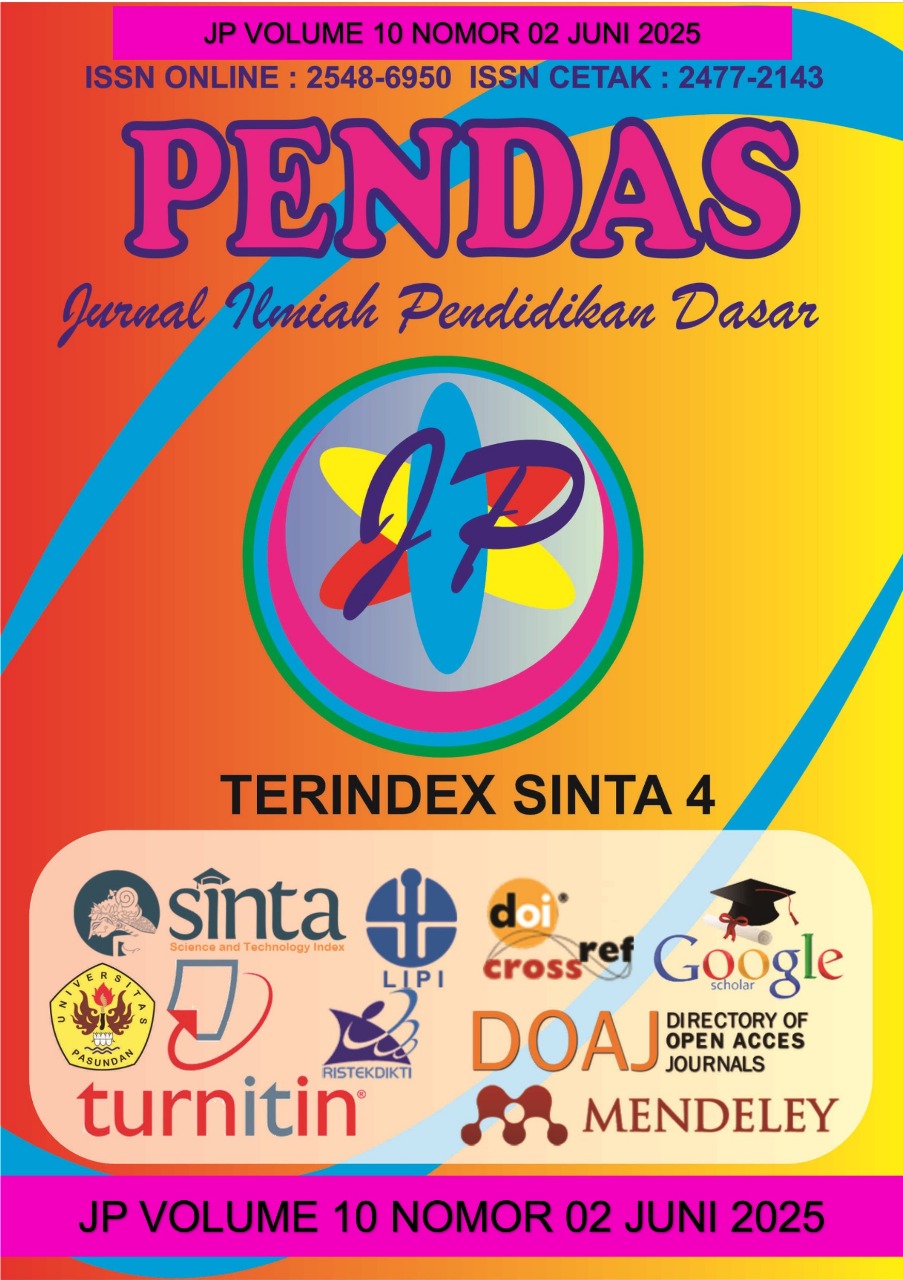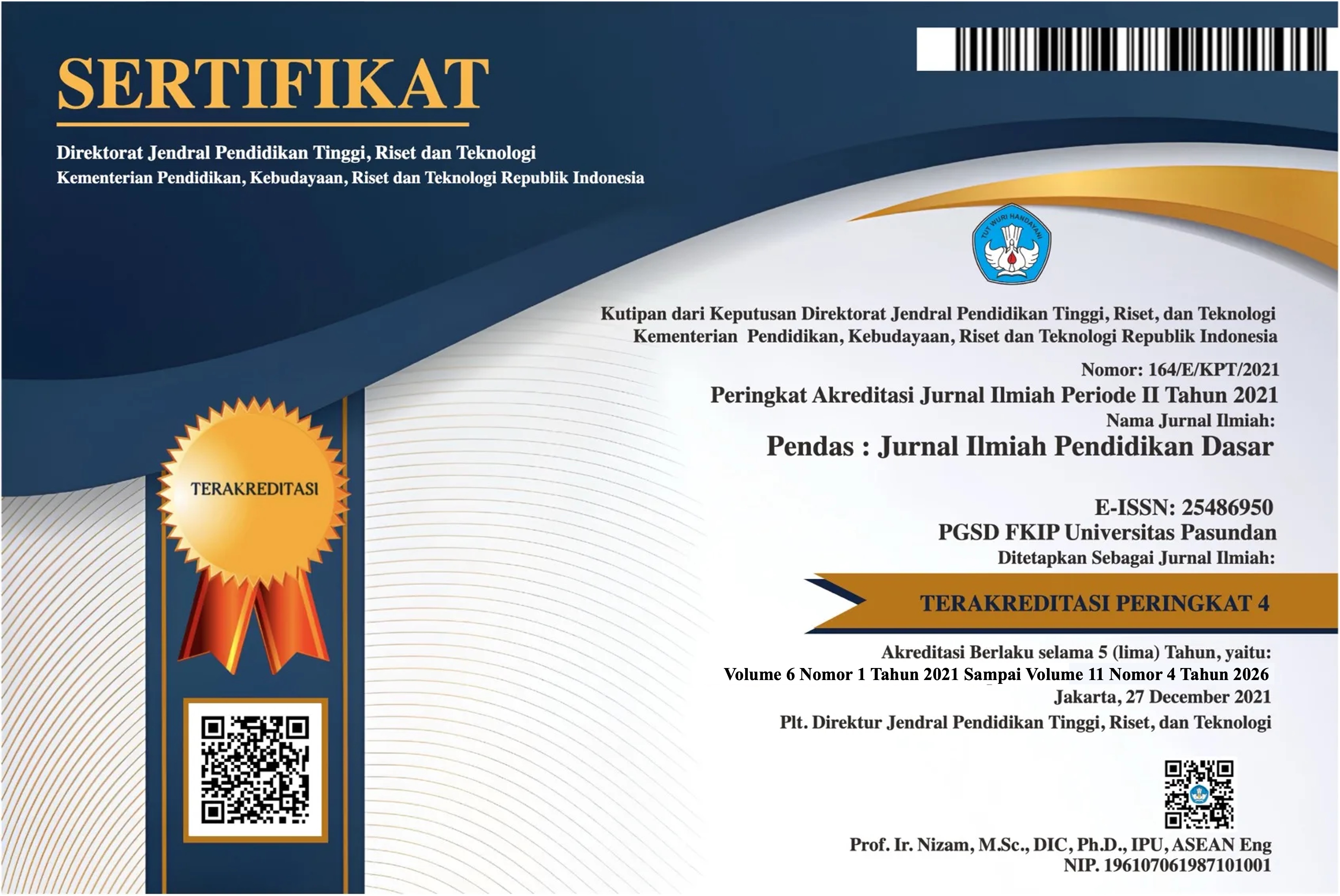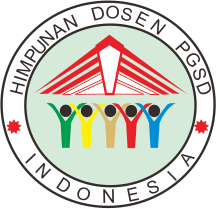PENINGKATAN HASIL BELAJAR DAN MOTIVASI PESERTA DIDIK DENGAN MODEL PEMBELAJARAN PBL BERBANTUAN KUIS INTERAKTIF PADA MATA PELAJARAN IPAS KELAS IV SD TAHUN 2024/2025
DOI:
https://doi.org/10.23969/jp.v10i2.25150Keywords:
motivation to learn, classroom action research, Problem Based Learning (PBL)Abstract
The objective of this classroom action research is to enhance both academic performance and learning motivation among fourth-grade students at SD Negeri Djama'atul Ichwan Surakarta in the IPAS subject through the implementation of the Problem-Based Learning (PBL) approach, supported by interactive quizzes. The low understanding and motivation of students in learning IPAS is the background of this research. The method of classroom action research (PTK) was applied to this study with two cycles in it, which was preceded by a pre-cycle stage. A total of 24 students in class IV D in the 2024/2025 academic year at SD Djama'atul Ichwan Surakarta became the research subjects. Data were collected through motivation questionnaires, learning assessments, and observation sheets. The data analysis combined quantitative methods with descriptive qualitative interpretation. The results showed a noticeable improvement in both learning outcomes and student motivation. During the pre-cycle phase, the percentage of students meeting the learning criteria was 58.3%. After applying the PBL model supported by interactive quizzes, the percentage increased to 79.16% in the first meeting of cycle I and 70.83% in the second meeting, further increasing to 75% in the first meeting of cycle II and reaching 83.3% in the second. Student motivation also improved, with scores rising from 71.92% in the first cycle to 77% in the second which was included in the high motivation to very high motivation category. These findings suggest that the use of the PBL model along with interactive quizzes is an effective strategy to enhance student learning outcomes and motivation in IPAS subjects.
Downloads
References
Citra, C. A., & Rosy, B. (2020). Keefektifan Penggunaan Media Pembelajaran Berbasis Game Edukasi Quizizz Terhadap Hasil Belajar Teknologi Perkantoran Siswa Kelas X SMK Ketintang Surabaya. Jurnal Pendidikan Administrasi Perkantoran (JPAP), 8(2), 261–272. https://doi.org/10.26740/jpap.v8n2.p261-272
Handayani, R. H., & Muhammadi, M. (2020). Pengaruh Model Pembelajaran Problem Based Learning Terhadap Hasil Belajar Siswa dalam Pembelajaran Tematik Terpadu di Kelas V SD. E-Journal Inovasi Pembelajaran SD, 8(5), 78–88.
Prastiwi, E., & Halijah, S. (2024). Penerapan Model PBL Berbantuan Media Pembelajaran Interaktif Wordwall dalam Upaya Meningkatkan Motivasi Belajar Peserta Didik Kelas V Sekolah Dasar. STKIP Persada Khatulistiwa: Jurnal Pendidikan Dasar Perkasa, 278–288.
Putri, E. O., Pratiwi, D. E., & Wati, E. S. (2024). Meningkatkan Hasil Belajar Peserta Didik Melalui Model Pembelajaran Problem Based Learning Berbantuan Media Wordwall Mata Pelajaran IPAS Kelas VI-A SDN Jajar Tunggal III / 452 Surabaya Universitas Wijaya Kusuma Surabaya , Indonesia pendidikan dalam mengha. Harmoni Pendidikan: Jurnal Ilmu Pendidikan, 1(4), 345–352. https://doi.org/https://doi.org/10.62383/hardik.v1i4.841
Rahman, A., Munandar, S. A., Fitriani, A., Karlina, Y., & Yumriani. (2022). Pengertian Pendidikan, Ilmu Pendidikan dan Unsur-Unsur Pendidikan. Al Urwatul Wutsqa: Kajian Pendidikan Islam, 2(1), 1–8.
Sihite, S., Saragih, M., & Sihombing, L. R. (2024). Meningkatkan Motivasi Belajar Peserta Didik Dengan Model Pembelajaran Problem Based Learning (PBL) Berbantuan Media Wordwall Pada Mata Pelajaran Matematika Kelas VI SD Negeri 060857 Medan Tembung. Didaktik: Junal Ilmiah PGSD FKIP Universitas Mnadiri, 10(3), 524–534. https://doi.org/https://doi.org/10.36989/didaktik.v10i03.4031
Syarifah Habibah. (2016). Penggunaan Model Pembelajaran Examples Non ExamplesTerhadap Ketuntasan Hasil Belajar Siswa Pada MateriTokoh-Tokoh Pergerakan NasionalKelas V Sdn 70 Banda Aceh. Jurnal Pesona Dasar, 3(4), 54–64.
Downloads
Published
Issue
Section
License
Copyright (c) 2025 Pendas : Jurnal Ilmiah Pendidikan Dasar

This work is licensed under a Creative Commons Attribution 4.0 International License.



















